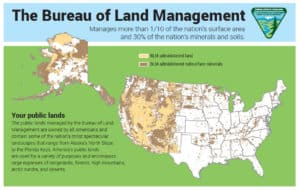Most of the articles I’ve read on the Infrastructure Bill talk about the bucks, and that’s certainly the most important thing. Still, with the Reconciliation Bill potentially adding more bucks into the spending pipeline, it’s also interesting to look at provisions that talk about structures for spending the money, or what we might call the Infrastructure of Infrastructure. What is also of interest is that while we’ve discussed the potential differences between restoration, hazardous fuel treatments, and fuel break projects, Congress is pretty careful in delineating each pot of money.
1. Developing a Fuelbreak system
Section 40803(i) requires a Wildfire Prevention Study of the construction and maintenance of a system of strategically placed fuelbreaks to control wildfires in western States. Upon completion of the study, the Secretary of Agriculture is required to determine whether to initiate a programmatic environmental impact statement to implement the system of strategically placed fuel breaks.
What we might find interesting about this is that it separates out fuelbreaks… the realm of fire suppression practitioners and fire scientists, and gives them their own space and planning without also needing to consider “restoration” NRV and other concepts (which have a separate pot). As to the programmatic EIS; many NEPA practitioners have not found these to be all that helpful. If litigatory groups don’t like the project, they get two bites at the litigatory apple (one programmatic and one project). There’s also the problem of analyzing and getting through a PEIS with accompanying litigation in five years, let alone any subsequent project NEPA. I still think an all-lands approach at perhaps a multiforest scale, and a site-specific EIS (for strategic fuelbreak establishment and maintenance) would be a better and faster way to go.
2. A Joint Plan for spending the money; hopefully before too much is spent.
Section 40803(j) requires USDA and DOI to establish a 5-year monitoring, maintenance and treatment plan that describes the how both will use the funding in subsection (c) to reduce the risk of wildfire and improve the Fire Regime Condition Class of 10,000 acres of Federal, Tribal or rangeland that is at very high risk of wildfire. Not later than 5 years after enactment, USDA and DOI are required to publish a long-term strategy to maintain forest health improvements and wildfire risk and to continue treatments at levels necessary to address the 20M acres needing priority treatment over the 10 year period post publication of the strategy.
I like how both 1 and 2 acknowledge not only what it takes to treat, but also to maintain.
5) the Wildfire Commission (section 70201)
ESTABLISHMENT.—Not later than 30 days after the date of enactment of this Act, the Secretaries shall jointly establish a commission to study and make recommendations to improve Federal
policies relating to—
(1) the prevention, mitigation, suppression, and management of wildland fires in the United States; and
(2) the rehabilitation of land in the United States devastated by wildland fires.
…
DATE.—The appointments of the members of the Commission shall be made not later than 60 days after the date of enactment of this Act.
The composition is fairly complex but appears to be about 11 feds and 18 others. The two secretaries are joint co-chairpersons. Ideally it will be a good way to highlight problems and improve, whilst avoiding partisanizing the issues- and yet having enough political oomph to get things done. Below is their list of things to do..
(1) IN GENERAL.—Not later than 1 year after the date of the first meeting of the Commission, the Commission shall submit to the appropriate committees of Congress a report
describing recommendations to prevent, mitigate, suppress, and manage wildland fires, including—
(A) policy recommendations, including recommendations—
(i) to maximize the protection of human life, community water supplies, homes, and other essential structures, which may include recommendations to expand the use of initial attack strategies;
(ii) to facilitate efficient short- and long-term forest management in residential and nonresidential at-risk areas, which may include a review of community wildfire protection plans;
(iii) to manage the wildland-urban interface;
(iv) to manage utility corridors;
(v) to rehabilitate land devastated by wildland fire;
and
(vi) to improve the capacity of the Secretary of Agriculture and the Secretary of the Interior to conduct hazardous fuels reduction projects;
(B) policy recommendations described in subparagraph
(A) with respect to any recommendations for—
(i) categorical exclusions from the requirement to prepare an environmental impact statement or analysis under the National Environmental Policy Act of 1969
(42 U.S.C. 4321 et seq.); or
(ii) additional staffing or resources that may be necessary to more expeditiously prepare an environmental impact statement or analysis under that Act;
(C) policy recommendations for modernizing and expanding the use of technology, including satellite technology, remote sensing, unmanned aircraft systems, and
any other type of emerging technology, to prevent, mitigate, suppress, and manage wildland fires, including any recommendations
with respect to—
(i) the implementation of section 1114 of the John D. Dingell, Jr. Conservation, Management, and Recreation Act (43 U.S.C. 1748b–1); or
(ii) improving early wildland fire detection; (D) an assessment of Federal spending on wildland fire-related disaster management, including—
(i) a description and assessment of Federal grant programs for States and units of local government for pre- and post-wildland fire disaster mitigation and
recovery, including—
(I) the amount of funding provided under each program;
(II) the effectiveness of each program with respect to long-term forest management and maintenance; and
(III) recommendations to improve the effectiveness of each program, including with respect to the conditions on the use of funds received under the program; and
H. R. 3684—827
(bb) the extent to which additional funds are necessary for the program;
(ii) an evaluation, including recommendations to improve the effectiveness in mitigating wildland fires, which may include authorizing prescribed fires, of—
(I) the Building Resilient Infrastructure and Communities program under section 203 of the Robert T. Stafford Disaster Relief and Emergency Assistance Act (42 U.S.C. 5133);
(II) the Pre-Disaster Mitigation program under that section (42 U.S.C. 5133);
(III) the Hazard Mitigation Grant Program under section 404 of that Act (42 U.S.C. 5170c);
(IV) Hazard Mitigation Grant Program postfire assistance under sections 404 and 420 of that Act (42 U.S.C. 5170c, 5187); and
(V) such other programs as the Commission determines to be appropriate;
(iii) an assessment of the definition of ‘‘small impoverished community’’ under section 203(a) of the Robert T. Stafford Disaster Relief and Emergency
Assistance Act (42 U.S.C. 5133(a)), specifically—
(I) the exclusion of the percentage of land owned by an entity other than a State or unit of local government; and
(II) any related economic impact of that exclusion;
and
(iv) recommendations for Federal budgeting for wildland fires and post-wildfire recovery;
(E) any recommendations for matters under subparagraph
(A), (B), (C), or (D) specific to—
(i) forest type, vegetation type, or forest and vegetation
type; or
(ii) State land, Tribal land, or private land;
(F)(i) a review of the national strategy described in the report entitled ‘‘The National Strategy: The Final Phase in the Development of the National Cohesive Wildland
Fire Management Strategy’’ and dated April 2014; and
(ii) any recommendations for changes to that national strategy to improve its effectiveness; and
(G)(i) an evaluation of coordination of response to, and suppression of, wildfires occurring on Federal, Tribal, State, and local land among Federal, Tribal, State, and local
agencies with jurisdiction over that land; and
(ii) any recommendations to improve the coordination described in clause (i).




